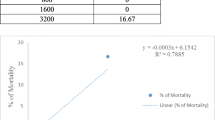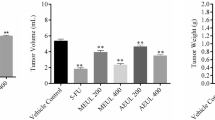Abstract
Cancer is the second death causing disease all over the world and until today 100 different types of cancer have been identified whose treatment methods consist of serious side effects on human body. To reduce the frequency of adverse effects of cancer treatment, nowadays plant derived natural components are getting priority. The plant Morus latifolia is widely available in northern part of Bangladesh. The earlier researches suggested that popular varieties of some Morus sp. like Morus alba, Morus indica etc. have good anti-proliferative activity. Hence, this study was designed to evaluate the anti-proliferative activity of leaf and bark extracts of M. latifolia against Ehrlich’s ascites carcinoma (EAC) in vivo. The leaf and bark extracts of M. latifolia were used in several bioassays including Brine shrimp lethality test, hemagglutination activity test, antioxidant activity test, and cell growth inhibition test. Besides, fluorescence microscopy was performed to study apoptotic features in EAC cells, and molecular analysis like real-time PCR were also conducted. The results of Brine shrimp lethality test, hemagglutination activity test, and antioxidant activity assay supported the cell growth inhibition capability of leaf and bark extracts which was confirmed by in vivo cell growth inhibition bioassay. Moreover, the experimental extracts were able to induce cell apoptotis through altering the expression pattern of Bcl-2 and Bax genes. All of the results of this study suggest that several noble compounds are present in M. latifolia plant extracts which are capable for healing cancer cells.






Similar content being viewed by others
References
Todaro M, Bonanno A, Tornambè G, Di Grigoli A, Luisa Scatassa M, Giaccone P (2009) Utilization of mulberry leaves (Morus latifolia cv. Kokusou 21) in diets for dairy ewes. Ital J Anim Sci 8:438–440
Bernal J, Mendiola JA, Ibez E, Cifuentes A (2011) Advanced analysis of nutraceuticals. J Pharm Bbiomed Anal 55:758–775
Iqbal S, Younas U, Chan KW, Sarfraz RA, Uddin MK (2012) Proximate composition and antioxidant potential of leaves from three varieties of Mulberry (Morus sp.): a comparative study. Int J Mol Sci 13:6651–6664
Islam MS, Rahi MS, Koli HK, Jerin I, Sajib SA, Hoque KMF, Reza MA (2018) Evaluation of phytochemical, antioxidant, cytotoxicity and in vitro antibacterial activity of aqueous extract of Ganoderma lucidum cultivated in Bangladeshi habitat. Malaya J Biosci 5:1–13
Niemi M, Sthle G (2016) The use of ayurvedic medicine in the context of health promotiona mixed methods case study of an ayurvedic centre in Sweden. BMC Complement Altern Med 16:62–75
Narayanaswamy V (1981) Origin and development of ayurveda:(a brief history). Anc Sci Life 1:1–7
Hou DX (2003) Potential mechanisms of cancer chemoprevention by anthocyanins. Curr Mol Med 3:149–159
Islam MS, Rahi MS, Jerin I, Hasan KE, Sajib SA, Ferdaus KMKB, Hoque KMF, Reza MA (2017) Antiproliferative, antioxidant and antibacterial activity of seed extract of Thuja occidentalis. Int J Biosci 11:372–386
Al-Mamun MA, Husna J, Khatun M, Hasan R, Kamruzzaman M, Hoque KMF, Reza MA, Ferdousi Z (2016) Assessment of antioxidant, anticancer and antimicrobial activity of two vegetable species of Amaranthus in Bangladesh. BMC Complement Altern Med 16:157–167
Tagne RS, Telefo BP, Nyemb JN, Yemele DM, Njina SN, Goka SMC, Lienou LL, Kamdje AHN, Moundipa PF, Farooq AD (2014) Anticancer and antioxidant activities of methanol extracts and fractions of some Cameroonian medicinal plants. Asian Pac J Trop Med 7:S442–S447
Krishnamoorthy M, Ashwini P (2011) Anticancer activity of Cynodon dactylon L. extract on Ehrlich ascites carcinoma. J Environ Res Dev 5:551–557
Fadeyi SA, Fadeyi OO, Adejumo AA, Okoro C, Myles EL (2013) In vitro anticancer screening of 24 locally used Nigerian medicinal plants. BMC Complement Altern Med 13:79–87
Cragg G, Newman D (2003) Plants as a source of anticancer and anti HIV agents. Ann Appl Biol 143:127–133
Gao PF, Watanabe K (2011) Introduction of the World Health Organization project of the international classification of traditional medicine. Zhong Xi Yi Jie He Xue Bao 9:1161–1164
Ferguson LR, Chen H, Collins AR, Connell M, Damia G, Dasgupta S, Malhotra M, Meeker AK, Amedei A, Amin A (2015) Genomic instability in human cancer: molecular insights and opportunities for therapeutic attack and prevention through diet and nutrition. Semin Cancer Biol 35:5–24
Bernstein C, Bernstein H (2015) Epigenetic reduction of DNA repairs in progression to gastrointestinal cancer. World J Gastrointest Oncol 7:30–46
Du L, Kim JJ, Chen B, Zhu S, Dai N (2017) Marital status is associated with superior survival in patients with esophageal cancer: a Surveillance, Epidemiology, and End Results study. Oncotarget 8:95965–95972
Roukos DH (2009) Genome wide association studies: how predictable is a persons cancer risk? Expert Rev Anticancer Ther 9:389–392
Alam AK, Hossain AS, Khan MA, Kabir SR, Reza MA, Rahman MM, Islam MS, Rahaman MAA, Rashid M, Sadik MG (2016) The antioxidative fraction of white mulberry induces apoptosis through regulation of p53 and NFKB in EAC cells. PLoS ONE 11:e0167536
Lü JM, Lin PH, Yao Q, Chen C (2010) Chemical and molecular mechanisms of antioxidants: experimental approaches and model systems. J Cell Mol Med 14:840–860
Brudner M, Karpel M, Lear C, Chen L, Yantosca LM, Scully C, Sarraju A, Sokolovska A, Zariffard MR, Eisen DP (2013) Lectin dependent enhancement of Ebola virus infection via soluble and transmembrane C type lectin receptors. PLoS ONE 8:e60838
Kabir SR, Nabi MM, Nurujjaman M, Reza MA, Alam AK, Zaman RU, Khalid BFK, Ruhul MA, Hasan MMK, Hossain MA (2015) Momordica charantia seed lectin: toxicity, bacterial agglutination and antitumor properties. Appl Biochem Biotechnol 175:2616–2628
Rutishauser U, Sachs L (1975) Cell-to-cell binding induced by different lectins. J Cell Biol 65:247–257
Elmore S (2007) Apoptosis: a review of programmed cell death. Toxicol Pathol 35:495–516
Reed JC (2000) Mechanisms of apoptosis. Am J Pathol 157:1415–1430
Searle J, Lawson T, Abbott P, Harmon B, Kerr J (1975) An electron microscope study of the mode of cell death induced by cancer chemotherapeutic agents in populations of proliferating normal and neoplastic cells. J Pathol 116:129–138
Balasubramanian A, Ramalingam K, Krishnan S, Ajm C (2005) Anti-inflammatory activity of Morus indica Linn. Iran J Pharmacol Ther 4:13–15
Khalid N, Fawad SA, Ahmed I (2011) Antimicrobial activity, phytochemical profile and trace minerals of black mulberry (Morus nigra L.) fresh juice. Pak J Bot 43:91–96
Kabir S, Islam F, Jahangir Alom M, Abu Zubair M, Absar N (2012) Purification, characterizations of a snake guard seeds lectin with antitumor activity against Ehrlich ascites carcinoma cells in vivo in mice. Protein Pept Lett 19:360–368
Hasan MM, Islam MS, Hoque KMF, Haque A, Reza MA (2019) Effect of Citrus macroptera fruit pulp juice on alteration of caspase pathway rendering anti-proliferative activity against Ehrlich’s ascites carcinoma in mice. Toxicol Res 35:271–277
Le VQA, Ahn JY, Heo MY, Cho SJ, Yoon H, Park J, Ko JH, Lee L, Han J, Kim SY (2017) Proteomic profiles of Daphnia magna exposed to lead (II) acetate trihydrate and atrazine. Genes Genomics 39:887–895
Brand-Williams W, Cuvelier ME, Berset C (1995) Use of a free radical method to evaluate antioxidant activity. LWT-Food Sci Technol 28:25–30
Sur P, Ganguly DK (1994) Tea plant root extract (TRE) as an antineoplastic agent. Planta Med 60:106–109
Jemal A, Murray T, Ward E, Samuels A, Tiwari RC, Ghafoor A, Feuer EJ, Thun MJ (2005) Cancer statistics, 2005. CA Cancer J Clin 55:10–30
Aruoma OI (1998) Free radicals, oxidative stress, and antioxidants in human health and disease. J Am Oil Chem Soc 75:199–212
Mukherjee PK, Kumar V, Houghton PJ (2007) Screening of Indian medicinal plants for acetylcholinesterase inhibitory activity. Phytother Res 21:1142–1145
Lpez-Lzaro M (2010) A new view of carcinogenesis and an alternative approach to cancer therapy. Mol Med 16:144–153
Meyer BN, Ferrigni NR, Putnam JE, Jacobsen LB, Nichols DJ, McLaughlin JL (1982) Brine shrimp: a convenient general bioassay for active plant constituents. Planta Med 45:31–34
Rieser MJ, Gu Z-M, Fang X-P, Zeng L, Wood KV, McLaughlin JL (1996) Five novel mono-tetrahydrofuran ring acetogenins from the seeds of Annona muricata. J Nat Prod 59:100–108
Jeyaprakash AA, Jayashree G, Mahanta S, Swaminathan C, Sekar K, Surolia A, Vijayan M (2005) Structural basis for the energetics of jacalinsugar interactions: promiscuity versus specificity. J Mol Biol 347:181–188
De Meja EG, Prisecaru VI (2005) Lectins as bioactive plant proteins: a potential in cancer treatment. Crit Rev Food Sci Nutr 45:425–445
Liu B, Bian HJ, Bao JK (2010) Plant lectins: potential antineoplastic drugs from bench to clinic. Cancer Lett 287:1–12
Kabir SR, Zubair MA, Nurujjaman M, Haque MA, Hasan I, Islam MF, Hossain MT, Hossain MA, Alam MT (2011) Purifica- tion and characterization of a Ca2+ dependent novel lectin from Nymphaea nouchali tuber with antiproliferative activities. Biosci Rep 31:465–475
Ahmed H, Chatterjee B, Debnath A (1988) Interaction and in vivo growth inhibition of Ehrlich ascites tumor cells by jacalin. J Biosci 13:419–424
Jaganathan SK, Mondhe D, Wani Z, Pal HC, Mandal M (2010) Effect of honey and eugenol on Ehrlich ascites and solid carcinoma. Biomed Res Int 2010:989163
Bhattacharyya A, Choudhuri T, Pal S, Chattopadhyay S, Datta GK, Sa G, Das T (2003) Apoptogenic effects of black tea on Ehrlichs ascites carcinoma cell. Carcinogenesis 24:75–80
Islam M, Rahi M, Jahangir CA, Rahman MH, Jerin I, Amin R, Hoque KMF, Reza MA (2018) In vivo anticancer activity of Basella alba leaf and seed extracts against Ehrlich’s ascites carcinoma (EAC) cell line. Evid Based Complement Altern Med 2018:1537896
Hyun JH, Kang JI, Kim SC, Kim E, Kang JH, Kwon JM, Park DB, Lee YJ, Yoo ES, Kang HK (2008) The effects of Crinum asiaticum on the apoptosis induction and the reversal of multidrug resistance in HL-60/MX2. Toxicol Res 24:29–36
Gomes A, Giri B, Alam A, Mukherjee S, Bhattacharjee P, Gomes A (2011) Anticancer activity of a low immunogenic protein toxin (BMP1) from Indian toad (Bufo melanostictus, Schneider) skin extract. Toxicon 58:85–92
Brown JM, Attardi LD (2005) The role of apoptosis in cancer development and treatment response. Nat Rev Cancer 5:231–237
Sa DJ, Lee EJ, Yoo BS (2009) Apoptosis induction by menadione in human promyelocytic leukemia HL-60 cells. Toxicol Res 25:113–118
Chinni SR, Li Y, Upadhyay S, Koppolu PK, Sarkar FH (2001) Indole-3-carbinol (I3C) induced cell growth inhibition, G1 cell cycle arrest and apoptosis in prostate cancer cells. Oncogene 20:2927–2936
Giannakakou P, Robey R, Fojo T, Blagosklonny MV (2001) Low concentrations of paclitaxel induce cell type dependent p53, p21 and G1/G2 arrest instead of mitotic arrest: molecular determinants of paclitaxel- induced cytotoxicity. Oncogene 20:3806–3813
Acknowledgements
All the authors are grateful to Dr. Saidur Rahman (Chief Scientific Officer, Bangladesh Sericulture Research and Training Institute, Rajshahi, Bangladesh) for providing the experimental plant materials.
Funding
There was no significant financial support for this research work.
Author information
Authors and Affiliations
Corresponding author
Ethics declarations
Conflict of interest
All the authors declared that there are no conflicts of interest about this paper for publication.
Additional information
Md. Shihabul Islam and Chowdhury Arif Jahangir have eqaully contributed and considered as first authors.
Rights and permissions
About this article
Cite this article
Islam, M.S., Jahangir, C.A., Rahi, M.S. et al. In-vivo antiproliferative activity of Morus latifolia leaf and bark extracts against Ehrlich’s ascites carcinoma. Toxicol Res. 36, 79–88 (2020). https://doi.org/10.1007/s43188-019-00011-7
Received:
Revised:
Accepted:
Published:
Issue Date:
DOI: https://doi.org/10.1007/s43188-019-00011-7




